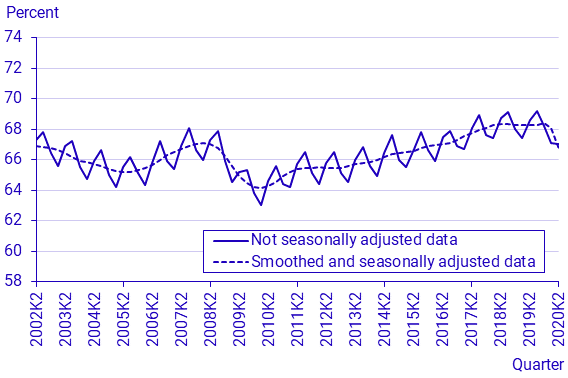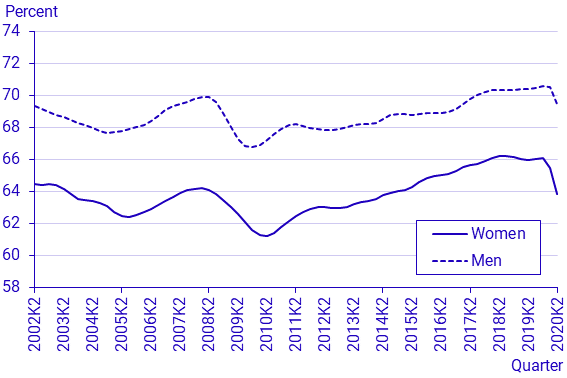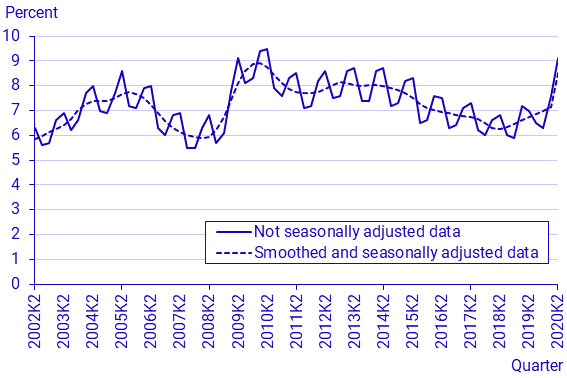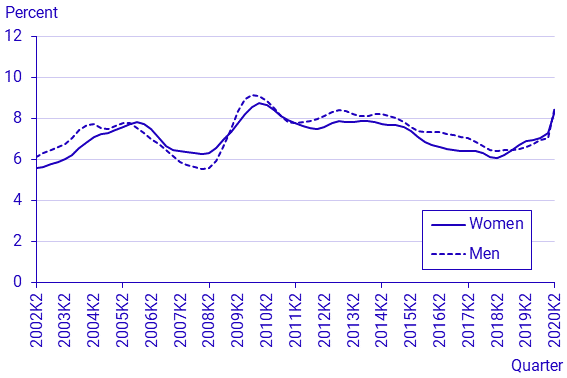Labour Force Surveys (LFS), 2nd quarter 2020
Decline in employment and rise in unemployment
Statistical news from Statistics Sweden 2020-08-11 9.30
The share of employed persons aged 15–74 in the second quarter of 2020 was 67.0 percent and the unemployment rate was 9.1 percent, non-seasonally adjusted. This means that the share of employed persons fell 1.6 percentage points and the unemployment rate rose 2.1 compared with the second quarter of 2019. The average number of hours worked amounted to 150.4 million per week, which is a decrease of 8.0 percent, calendar-adjusted. Seasonally adjusted and smoothed data shows a sustained decline in employment, while unemployment is on the rise.
The labour force
The number of persons in the labour force aged 15–74 was 5 553 000 in the second quarter of 2020, non-seasonally adjusted. Compared with the second quarter of 2019, the number of men in the labour force increased by 44 000 to 2 941 000. The number of women in the labour force was 2 612 000. The labour force participation rate was 73.7 percent. For women, it was 70.6 percent, down 0.9 percentage points, and for men it was 76.7 percent, up 0.8 percentage points.
Seasonally adjusted and smoothed data shows that there were 5 494 000 persons in the labour force, which is 26 000 fewer than in the first quarter of 2020. The labour force participation rate was 72.9 percent, down 0.4 percentage points.
Employment
In the second quarter of 2020, the number of employed persons aged 15–74 was 5 048 000, non-seasonally adjusted, which is a decrease of 98 000 compared with the same quarter of 2019. The employment rate was 67.0 percent, down 1.6 percentage points. The number of employed women was 2 375 000, down 74 000, and men numbered 2 673 000. Among women the employment rate was 64.2 percent, which is a decrease of 2.2 percentage points, and among men it was 69.7 percent, which is a decrease of 0.9 percentage points.
According to seasonally adjusted and smoothed data, the number of employed persons was 5 026 000. This is a decrease of 99 000, 43 000 of whom were young persons, compared to the first quarter of 2020. The employment rate for persons aged 15–74 was 66.7 percent, down 1.4 percentage points compared with the first quarter of 2020.
Employees
In the second quarter of 2020 the number of employees was 4 545 000, non-seasonally adjusted, which is a decrease of 97 000 compared with the same quarter of the previous year. Out of employees, 2 237 000 were women, which is a decrease of 75 000, and 2 308 000 were men. There were 3 853 000 permanent employees. Among permanent employees, 1 871 000 were women and 1 982 000 were men. The number of temporary employees decreased by 87 000 and amounted to 692 000. Among temporary employees, 367 000 were women, down 65 000, and 325 000 were men.
Compared with the first quarter of 2020, seasonally adjusted and smoothed data shows a 96 000 decline in the number of employees, 78 000 of whom were temporary employees.
Hours worked
The total number of hours worked averaged 150.4 million per week, according to non-seasonally adjusted data in the second quarter of 2020. In calendar-adjusted terms, this corresponds to a decrease of 8.0 percent compared with the second quarter of 2019.
According to seasonally adjusted and smoothed data, the number of hours worked averaged 142.0 million hours per week. This is 10.7 million fewer hours per week than in the first quarter of 2020.
The majority of employed persons have an agreed working time of 35 hours or more per week, that is, full-time work. In the second quarter of 2020, 3 916 000 persons worked full time, which is a decrease of 115 000 persons. Out of these, 2 237 000 were men, down 62 000 persons, and 1 679 000 were women, down 53 000. In total, 338 000 persons worked short part-time (1–19 hours) and 776 000 persons worked long part-time (20–34 hours).
The average actual hours worked among employed persons aged 15–74 amounted to 29.8 hours per week in the second quarter of 2020. This is 0.9 fewer hours than in the second quarter of 2019. Women worked 27.6 hours and men worked 31.8 hours, down 1.4 hours.
In work and absence
The number of persons who were employed and in work was 4 461 000 in the second quarter of 2020, non-seasonally adjusted. In calendar-adjusted terms, this is a decrease of 4.5 percent compared with the same quarter of the prior year.
The LFS estimates the number of persons who were absent for the whole week or for part of the week from their principal occupation by main reason for absence. The number of persons who were absent for the whole week in the second quarter of 2020 was 595 000, non-seasonally adjusted. This is an increase of 46 000 compared to the same period the year before. Out of these, 167 000 were absent due to illness, an increase of 60 000. The number of persons absent for the whole week due to lack of work was 41 000, and the number of persons absent due to lay-offs was 44 000. At the same time, the number of persons who were absent due to holiday decreased by 107 000.
Among persons who are absent due to lack of work or lay-offs, it is common that the absence is only for a part of the week. The total number of persons who were absent for the whole week or part of the week due to lay-offs was 238 000. The corresponding figure for persons who stated lack of work as the main reason for absence was 106 000.
Seasonally adjusted and smoothed data shows that there were 4 117 000 persons in work, which is 185 000 fewer than in the first quarter of 2020. There were 909 000 persons absent for the whole week, which is an increase of 86 000 compared with the first quarter of 2020.
Underemployment
Among employed persons aged 15–74, 334 000 were underemployed in the second quarter of 2020, an increase of 39 000 persons. Out of underemployed persons, 171 000 were men, an increase of 27 000, and 162 000 were women. Underemployed persons accounted for 6.6 percent of employed persons.
Unemployment
In the second quarter of 2020, there were 505 000 unemployed persons aged 15–74, non-seasonally adjusted, which is an increase of 116 000 persons. This corresponds to an unemployment rate of 9.1 percent, which is an increase of 2.1 percentage points. The number of unemployed women was 237 000, which is an increase of 48 000. The number of unemployed men was 269 000, which is an increase of 68 000. Among both women and men, the unemployment rate was 9.1 percent. The unemployment rate increased 2.2 percentage points among men and 1.9 percentage points among women.
For persons aged 15–74, seasonally adjusted and smoothed data shows a 73 000 increase in the number of unemployed persons and a 1.4 percentage point increase in the share of unemployed persons compared with the first quarter of 2020. In the second quarter of 2020, there were 468 000 unemployed persons, which corresponds to an unemployment rate of 8.5 percent.
The number of long-term unemployed persons (unemployed for at least 27 weeks) aged 15–74 was 92 000 in the second quarter of 2020, non-seasonally adjusted. 50 000 men and 43 000 women were long-term unemployed.
There were 196 000 unemployed young persons aged 15–24, non-seasonally adjusted, an increase of 41 000. This corresponds to an unemployment rate of 30.3 percent, an increase of 7.0 percentage points. Among unemployed young persons, 127 000 were full-time students, which is an increase of 26 000.
Among young persons aged 15–24, seasonally adjusted and smoothed data shows an increase in both the number and in the share of unemployed persons compared with adjacent quarters. The number of unemployed persons was 159 000, an increase of 34 000. The unemployment rate was 26.4 percent, up 5.9 percentage points.
Not in the labour force
The group ‘not in the labour force’ includes persons who are not classified as employed nor as unemployed. In the second quarter of 2020, there were 1 982 000 persons not in the labour force, of whom 894 000 were men and 1 089 000 were women. The number of women increased by 40 000.
Among persons not in the labour force, there were 931 000 retired persons. Furthermore, there were 519 000 full-time students and 238 000 persons who reported that they were on long-term sick leave.
Latent job seekers
The number of latent job seekers aged 15–74 was 174 000 persons in the second quarter of 2020, an increase of 65 000. Among young persons aged 15–24, the number of latent job seekers was 87 000, an increase of 35 000.
Unused labour supply
Unemployed persons, underemployed persons and latent job seekers together make up the unused labour supply. In the second quarter of 2020, the unused labour supply averaged 24.8 million hours per week, which is 6.4 million hours more than a year ago. The unused labour supply corresponds to 620 000 full-time employments with a 40-hour working week.
Labour market for persons aged 20–64
The relative labour force participation rate among persons aged 20–64 was 87.4 percent in the second quarter of 2020, non-seasonally adjusted. Among women, the relative participation rate was 84.4 percent, a decrease of 0.9 percentage points, and among men it was 90.2 percent. Seasonally adjusted and smoothed data shows a decrease in the labour force participation rate, which amounted to 86.9 percent.
In the second quarter of 2020, the share of employed persons aged 20–64 was 80.6 percent, which is a decrease of 1.8 percentage points, non-seasonally adjusted. For women, the corresponding figure was 78.1 percent, down 2.1 percentage points, and for men it was 83.1 percent, down 1.5 percentage points. Seasonally adjusted and smoothed data shows a decrease in the employment rate, which was 80.3 percent.
According to non-seasonally adjusted data, the unemployment rate in the age group 20–64 was 7.7 percent, an increase of 1.9 percentage points. Unemployment among women was 7.5 percent, up 1.6 percentage points, and 8.0 percent among men, up 2.3 percentage points. Compared with adjacent quarters, seasonally adjusted and smoothed data shows an increase in the share of unemployed persons, which was 7.6 percent.
Swedish born and foreign born persons aged 20–64
The relative labour force participation rate among Swedish born persons aged 20–64 was 89.4 percent in the second quarter of 2020, non-seasonally adjusted. Among Swedish born women, the relative participation rate was 87.7 percent and among Swedish born men it was 91.0 percent. Among foreign born persons aged 20–64, the relative participation rate was 81.4 percent in the second quarter of 2020. The corresponding figure was 74.7 percent among foreign born women and 87.9 percent among foreign born men. Seasonally adjusted and smoothed data shows a decrease in the labour force participation rate for both Swedish born and foreign born persons compared with adjacent quarters. The labour force participation rate was 88.8 percent among Swedish born persons and 81.2 percent among foreign born persons.
In the second quarter of 2020, the share of employed Swedish born persons aged 20–64 was 85.2 percent, which is a decrease of 1.2 percentage points, non-seasonally adjusted. Among Swedish born women the employment rate was 84.0 percent, which is a decrease of 1.2 percentage points, and among Swedish born men it was 86.4 percent, which is a decrease of 1.0 percentage point. Among foreign born persons, the employment rate was 67.0 percent, down 3.5 percentage points. For foreign born men, the corresponding figure was 73.0 percent, down 2.7 percentage points, and for foreign born women it was 60.7 percent, down 4.6 percentage points. Seasonally adjusted and smoothed data shows a decrease in the employment rate for both Swedish born and foreign born persons compared with adjacent quarters. The employment rate was 84.9 percent among Swedish born persons and 66.8 percent among foreign born persons.
The relative unemployment rate for Swedish born persons aged 20–64 was 4.7 percent in the second quarter of 2020, an increase of 1.3 percentage points. Unemployment among Swedish born women increased by 0.9 percentage points, amounting to 4.3 percent, and to 5.0 percent for men, up 1.6 percentage points. Unemployment among foreign born persons was 17.8 percent, an increase of 3.9 percentage points compared with the second quarter of 2019. For foreign born women it was 18.7 percent and for men it was 17.0 percent. This is an increase of 4.2 percentage points for women and 3.7 percentage points for men. Seasonally adjusted and smoothed data shows an increase in the unemployment rate for both Swedish born and foreign born persons, compared with adjacent quarters. The unemployment rate was 4.5 percent for Swedish born persons and 17.7 percent for foreign born persons.




Definitions and explanations
Since the LFS is a sample survey, the results are subject to some uncertainty. The LFS basic tables contain uncertainty figures and refer to non-seasonally adjusted data.
Seasonally adjusted and smoothed data (trend values): data in which normal seasonal variations have been removed, then smoothed to reduce sampling error and short-term variations. Seasonally adjusted and smoothed data may be revised following new monthly outcomes and usually does not coincide with non-seasonally adjusted data. Seasonally adjusted and smoothed data is not to be compared with non-seasonally adjusted data.
More detailed results are available in the form of figures and tables on employed persons, hours worked, unemployed persons and more, on Statistics Sweden’s website.
Next publishing will be
2020-10-27 at 09:30.
Feel free to use the facts from this statistical news but remember to state Source: Statistics Sweden.
